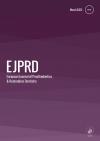European Journal of Prosthodontics and Restorative Dentistry
Evaluation of Mechanical Behavior of CAD/CAM Polymers for Long-term Interim Restoration Following Artificial Aging
Abstract
Mechanical properties are crucial parameters for the clinical performance of longterm CAD/CAM interim restorations. This study aimed to evaluate and compare fracture toughness (FT), flexural strength (FS), flexural modulus (FM), microhardness (H), and the brittle index (BI) of three different long-term interim restorative materials after simulated ageing. CAD-Temp; VCT, Everest C-Temp; CT, and PEEK; PK were the materials used. Specimens were divided into subgroup A (control group) with no thermocycling, and subgroup B subjected to 5000 thermocycles between 5 and 55 °C for 30 seconds. FS, FM, FT, H, microstructure, and the brittle index were evaluated. The data was examined using two-way ANOVA and Tukey’s test for post-hoc comparisons. In the VCT group, FS, FT, and H were significantly reduced (p <0.05) after thermocycling. In the PK group, no statistically significant differences (p >0.05) were detected between the aged and non-aged groups. As for the CT group, the tested properties were significantly reduced (p <0.05) after simulated aging condition. The PK group recorded appropriate mechanical
behavior both before and after simulating aging, in addition to its better machinability than other materials. The CT group had better mechanical properties before and after ageing, despite the significant reduction in mechanical properties after aging.
Keywords
Mechanical Properties
Artificial Aging
Interim Restoration
Authors
Tarek A. Soliman, Eman M. Raffat, Dina S. Farahat
Articles from this issue
 Free Access
Free Access No Access
No Access Full Access
Full Access


